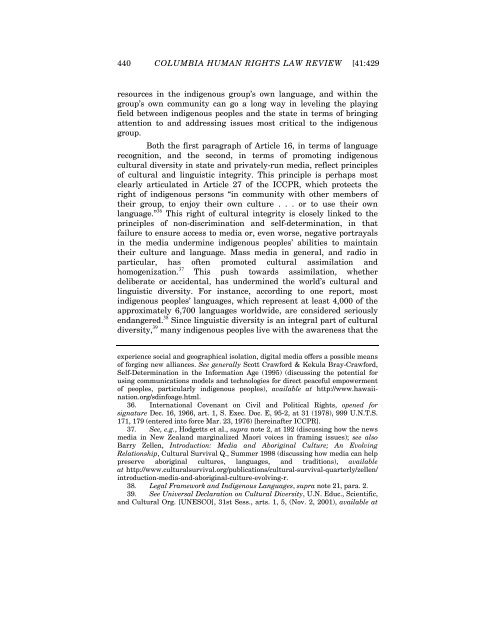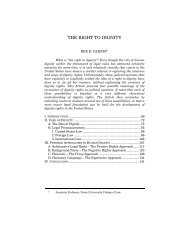A Right to Media? Lorie M. Graham - Columbia Law School
A Right to Media? Lorie M. Graham - Columbia Law School
A Right to Media? Lorie M. Graham - Columbia Law School
Create successful ePaper yourself
Turn your PDF publications into a flip-book with our unique Google optimized e-Paper software.
440 COLUMBIA HUMAN RIGHTS LAW REVIEW [41:429<br />
resources in the indigenous group’s own language, and within the<br />
group’s own community can go a long way in leveling the playing<br />
field between indigenous peoples and the state in terms of bringing<br />
attention <strong>to</strong> and addressing issues most critical <strong>to</strong> the indigenous<br />
group.<br />
Both the first paragraph of Article 16, in terms of language<br />
recognition, and the second, in terms of promoting indigenous<br />
cultural diversity in state and privately-run media, reflect principles<br />
of cultural and linguistic integrity. This principle is perhaps most<br />
clearly articulated in Article 27 of the ICCPR, which protects the<br />
right of indigenous persons “in community with other members of<br />
their group, <strong>to</strong> enjoy their own culture . . . or <strong>to</strong> use their own<br />
language.” 36 This right of cultural integrity is closely linked <strong>to</strong> the<br />
principles of non-discrimination and self-determination, in that<br />
failure <strong>to</strong> ensure access <strong>to</strong> media or, even worse, negative portrayals<br />
in the media undermine indigenous peoples’ abilities <strong>to</strong> maintain<br />
their culture and language. Mass media in general, and radio in<br />
particular, has often promoted cultural assimilation and<br />
homogenization. 37 This push <strong>to</strong>wards assimilation, whether<br />
deliberate or accidental, has undermined the world’s cultural and<br />
linguistic diversity. For instance, according <strong>to</strong> one report, most<br />
indigenous peoples’ languages, which represent at least 4,000 of the<br />
approximately 6,700 languages worldwide, are considered seriously<br />
endangered. 38 Since linguistic diversity is an integral part of cultural<br />
diversity, 39 many indigenous peoples live with the awareness that the<br />
experience social and geographical isolation, digital media offers a possible means<br />
of forging new alliances. See generally Scott Crawford & Kekula Bray-Crawford,<br />
Self-Determination in the Information Age (1995) (discussing the potential for<br />
using communications models and technologies for direct peaceful empowerment<br />
of peoples, particularly indigenous peoples), available at http://www.hawaiination.org/sdinfoage.html.<br />
36. International Covenant on Civil and Political <strong>Right</strong>s, opened for<br />
signature Dec. 16, 1966, art. 1, S. Exec. Doc. E, 95-2, at 31 (1978), 999 U.N.T.S.<br />
171, 179 (entered in<strong>to</strong> force Mar. 23, 1976) [hereinafter ICCPR].<br />
37. See, e.g., Hodgetts et al., supra note 2, at 192 (discussing how the news<br />
media in New Zealand marginalized Maori voices in framing issues); see also<br />
Barry Zellen, Introduction: <strong>Media</strong> and Aboriginal Culture; An Evolving<br />
Relationship, Cultural Survival Q., Summer 1998 (discussing how media can help<br />
preserve aboriginal cultures, languages, and traditions), available<br />
at http://www.culturalsurvival.org/publications/cultural-survival-quarterly/zellen/<br />
introduction-media-and-aboriginal-culture-evolving-r.<br />
38. Legal Framework and Indigenous Languages, supra note 21, para. 2.<br />
39. See Universal Declaration on Cultural Diversity, U.N. Educ., Scientific,<br />
and Cultural Org. [UNESCO], 31st Sess., arts. 1, 5, (Nov. 2, 2001), available at















